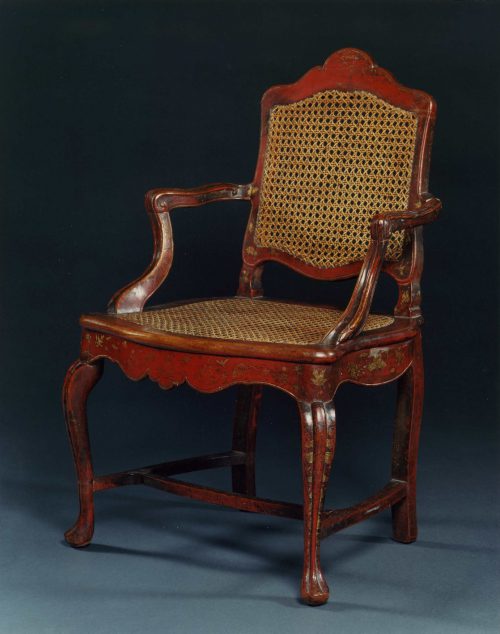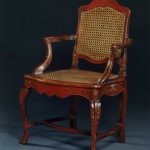9291 A CHARMING PAIR OF RED LACQUER RÉGENCE PERIOD FAUTEUILS WITH UNUSUAL GILDED DECORATION Probably Portuguese. Second Quarter Of The Eighteenth Century. Measurements: Height: 36″ (91.5 cm) Width: 24″ (61 cm) Depth: 20 3/4″ (52.5 cm)

-
Figure 1
Research
Of walnut and red lacquer with gilded decoration. Each back with undulating shaped top-rail raised on shaped uprights and issuing curving channeled arms scrolling at the handles and raised on outward-curving channeled uprights, the cane seat with serpentine sides, bowed to the front on an undulating apron, decorated with birds, leaves, insects and animals, the whole raised on four legs, the pair to the front of channeled and cabriole form, joined by an h-stretcher.
In the Régence, comfort, convenience and elegance were prized above grandeur, and the era of sophisticated petits apartments had begun. In keeping with the new spirit, rooms were smaller and more intimate, and chairs increasingly fitted to feminine contours rather than being accessories to the rigid and complex court etiquette of the Louis XV period. Lighter, and therefore more mobile, cane-upholstered chairs became widely used in the most sophisticated circles. This fashion was sparked by Madame de Pompadour, who introduced caned chairs into the most refined settings. These were mainly painted, lacquered or gilded and much inspired by the forms, colors and imagery of the chinoiserie.1
Although the present chairs are clearly derived from French prototypes, their unusually exotic decoration and their reeded front cabriole legs are not consistent with a French origin. They are decorated with a profusion of insects, such as beetles, bees, butterflies, dragonflies and even grasshoppers.
This decoration, combined with their Portuguese provenance, has led us to speculate on that country as their possible origin. A Portuguese walnut sewing armchair with caned back and seat, circa the second half of the 18th century (figure 1), is of a similar form and helps to support this theory.
Footnotes:
1. De Dampiere, Florence. Chairs: A History. New York: Abrams, 2006. 183.


Comments are closed.